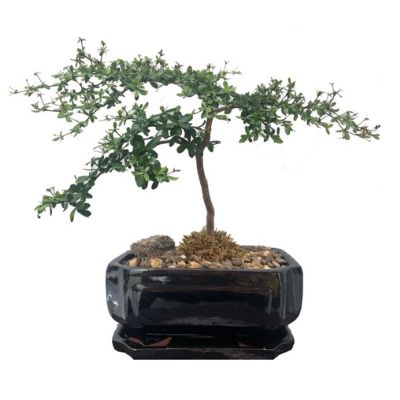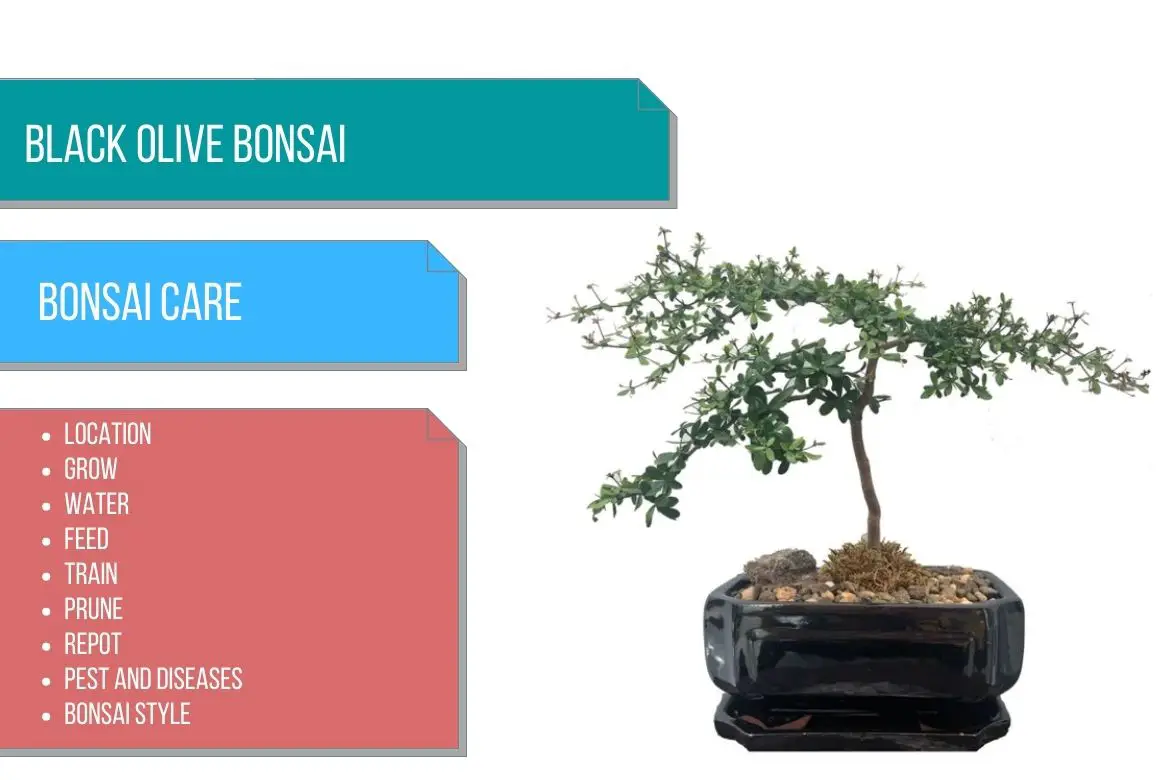
Black Olive
(Bucida molineti / Bucida Spinosa)
Country of Origin : North America, Caribbean
Bonsai Styles : Informal upright, cascade, windswept
Zone : 10 – 11
Black olive, also known as Bucida molineti or Bucida Spinosa, should not be confused with the edible olives we are familiar with. It shares a common name with the Mediterranean olives, however, these trees belong to a different genus.
These are different form the real olive bonsai tree (Olea europaea bonsai tree).
Black olive tree’s short, thin branches and tight growth habit make it ideally suited for bonsai (specially for windswept bonsai style). Also, the branches change direction dramatically at their nodes.
The plant has small, dark blue-green leaves that are closely spaced.
It has cream colored flowers. Initially the fruit is green, but changes to a reddish brown color as it ripens.
Because the black olive can handle salinity quite well, bonsai enthusiasts who plan to plant outdoor summer collections near the sea will find it an excellent choice.
Best location to keep Black Olive Bonsai
Bucida Spinosa bonsai tree thrives in full sun.
A good temperature range for its growth is 65 to 75 °F (18 to 23°C).
It can be kept outside in summers. However, when ever temperature drops below 50°F (10°C), move the bonsai pot to indoor location in warmer temperature.
In indoor settings, place it in a location facing south or west where it can receive maximum sunlight.
Refer sunlight requirements for indoor plants for more indoor gardening ideas. Also, refer to do bonsai trees need sunlight for more indoor and outdoor bonsai location ideas.
Propagation of Black Olive
Black olives can be propagated using seeds, stem cuttings and air layering.
The seed germination rate is low. However, when you try and grow it via sowing seeds, do it in summer or spring and keep the pot in sun all the time. make sure that the temperature is above 50°F (10°C). The seeds will sprout the next spring.
Some people even advise to not touch the seeds and let the seeds fall directly on to the seed tray. Let it sow naturally.
Propagate it by using hardwood cuttings is difficult even when the humidity is raised. Propagate the trees by using softwood cuttings.
Air layering is a very good method to grow a thick trunk quickly. Try and do this early in the growing season so that you can have the roots develop in the same year (in 5-6 months) and then you can cut this trunk and plant it in a pot.
Watering Black Olive Bonsai
Water frequently, especially in hot summers. Allow the bonsai soil to become a little dry to the touch before the subsequent watering.
Keep in mind that these trees are prolific growers. They love a little wet roots in summer. However, to achieve this, you should have good drainage in the pot.
Do not over-water and make the root ball saturated. This will damage the plant.
In winter, keep the soil just moist.
Read watering bonsai tree for more details.
Wiring Black Olive Bonsai
Most of the time you will not need to wire these plants. Because they naturally produce this flat spreading foliage.
However, if you still want to wire train you bonsai, a black olive branches and trunk should be wired at an early stages of growth. Be careful when you wire the tree because of the pointed thorns.
Furthermore, black olive tree has flexible branches, which is an advantage for beginner bonsai enthusiasts.
Pruning Black Olive Bonsai
When to prune Black Olive bonsai?
How to prune Black Olive bonsai?
You can prune the bonsai once new growth appears and four or five new sets of leaves appear on the branch.
It is imperative to remove excess branches to allow light to penetrate. This will ensure a healthy growth of inner shoots. Take care of the thorns while pruning. The spines can grow to a length of 1/2 inch sometimes.
Thorns can either be cut off as necessary, or spray water and soak the tree for about 30 minutes to make them softer before pruning.
When you prune a branch of a black olive, it does not grow new branches from around the wound. Let the new shoots mature to a longer branch length than you eventually want it to be, and then work on shortening the branch later.
Also, pruning long branches promotes vigorous growth.
Also, prune the branches which grow vertically or branches which overlap other branches and trunk.

You should avoid creating Jin and Shari since the bark cracks easily leaving the tree exposed to fungi.
Repotting Black Olive Bonsai
When to repot Black Olive bonsai?
Black olives live bonsai tree can be repotted in late winter every year.
However, you can also repot the plant early summer. In repotting at this time, you’ll ensure that the bonsai tree receives at least 6 weeks of temperatures above 50°F (10°C) at night.
You can also prune the roots at the time of repotting. Prune almost half an inch of root from all the sides.
You can use a basic free-draining bonsai soil mix as a potting soil.
OR
You can also use a soil mix consisting of 75% grit and 25% organic matter.
Must Read: Bonsai Soil Recipes
Must read : Choosing the right bonsai container
Feeding Black Olive Bonsai
Fertilize your Bucida Spinosa bonsai tree with a balanced fertilizer every week at half strength.
In the winter, reduce the feeding frequency to every two to three weeks.
Read more about bonsai fertilizer and its application.
Diseases and pest of Black Olive Bonsai
Bucida Spinosa bonsai trees can be infested by spider mites and scaled insects. Use a systemic insecticide or remove them by hands.
These trees can also be affected by sooty mold in damp conditions. Keep good air circulation and apply a mild fungicide if necessary.
Black Olive bonsai care
Black olive bonsai tree makes a good indoor bonsai tree. Keep it in a sunny window and do not let it dry. Know more about best house locations for indoor plants.
If they become too dry, they will start shedding their leaves.
Also, these trees have a tendency of shedding leaves in spring. So do not panic. New leaves will emerge soon.
Bucida Spinosa bonsai doesn’t drop its leaves in winters.
Don’t be surprised if you find yourself pruning the tree quite often. These tree grow quite rapidly once the growing season starts.
What to look for when buying Black Olive Bonsai
Avoid buying them in spring. As mentioned earlier, these trees will shed leaves in spring. This will make it hard for you to judge if the tree is healthy or not.
In winters, the leaves are not in a great shape. In case you are a beginner, there is a chances that you will think that the tree is unhealthy.

